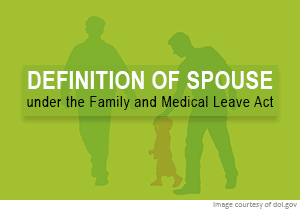
On February 25, 2015, the U.S. Department of Labor (DOL) issued new rules revising the regulatory definition of “spouse” under the Family and Medical Leave Act of 1993 (FMLA), which entitles eligible employees of covered employers to take unpaid, job-protected leave for specified family and medical reasons.
What prompted this change? Previously the definition of spouse for purposes of FMLA was based on the state where the employee resides and, because it is a federal law, it relied on the definition of marriage under the Defense of Marriage Act (DOMA), which defined a marriage as being between one man and one woman. In the U.S. Supreme Court’s decision in United States v. Windsor, the court struck down this definition under DOMA as unconstitutional. However, FMLA regulations maintained the state of residence rule for defining a spouse. This left multi-state employers with the burden of keeping up with the ever-changing same-sex marriage landscape at the state level to ensure employees, needing leave to care for their same-sex spouse, were being afforded the protections of the FMLA based on their state of residence.
Following the Windsor decision, President Obama instructed all federal agencies, like the DOL, to review any relevant statutes and implement that decision. Therefore, the DOL announced its revision of the definition of spouse under FMLA regulations on February 25. The revised definition becomes effective on March, 27, 2015, as follows:
“Spouse, as defined in the statute, means a husband or wife. For purposes of this definition, husband or wife refers to the other person with whom an individual entered into marriage as defined or recognized under state law for purposes of marriage in the State in which the marriage was entered into or, in the case of a marriage entered into outside of any State, if the marriage is valid in the place where entered into and could have been entered into in at least one State. This definition includes an individual in a same-sex or common law marriage that either:
(1) Was entered into in a State that recognizes such marriages; or
(2) If entered into outside of any State, is valid in the place where entered into and could have been entered into in at least one State.”
What does this mean for employers who are subject to FMLA? Most significantly, the administration of leaves for same-sex spouses will be less burdensome as employers will not have to keep track of whether a same-sex marriage is legal where the employee resides but rather only if the marriage was legal in the state where it was entered into or as the DOL refers to as the “place of celebration.”
The DOL announcement on the new rules is available here.
Things employers need to consider as a result of this change:
- Update FMLA policies if they currently include a detailed definition of spouse.
- Use caution in requiring proof of same-sex marriage if you do not require proof of marriage for opposite-sex spouses for purposes of taking leave.
- Train supervisors or anyone involved in the FMLA process of the change in definition as some employees will be entitled to FMLA protection where they were not in the past.
- Remember this change does not impact state leave laws that provide leave for Domestic Partners or Civil Union partners. While the employee would not be eligible to take leave under FMLA (only applies to legal same-sex marriages), they still may be allowed leave under state law.
- If you outsource your leave administration to a third party, ensure the third party is in compliance with this change.
Do you have additional questions regarding this change? If so I would be happy to answer them. Feel free to leave a response in the comments section or send me an email.
Sharon Andrus, Director National Technical Compliance, Disability Administration